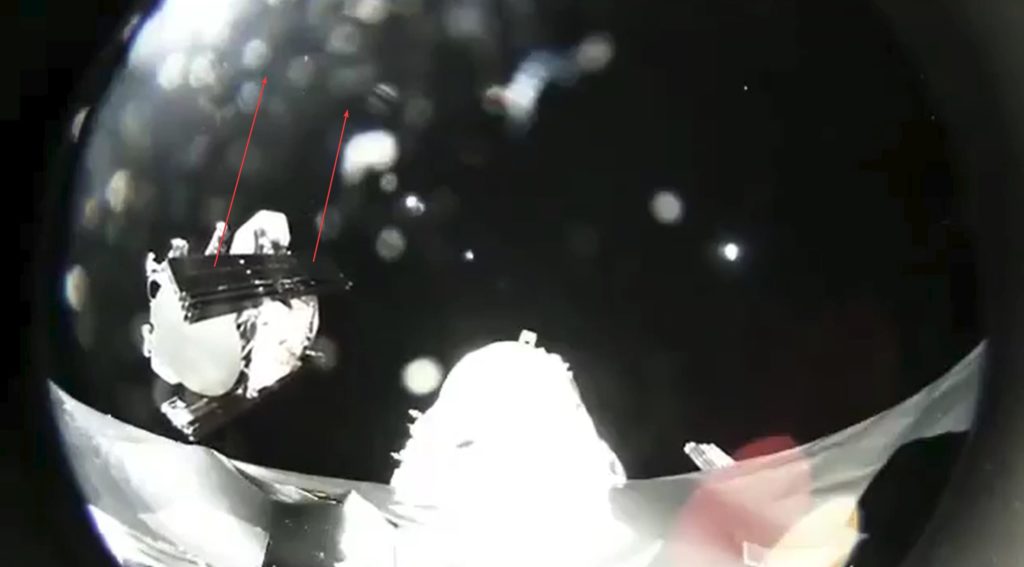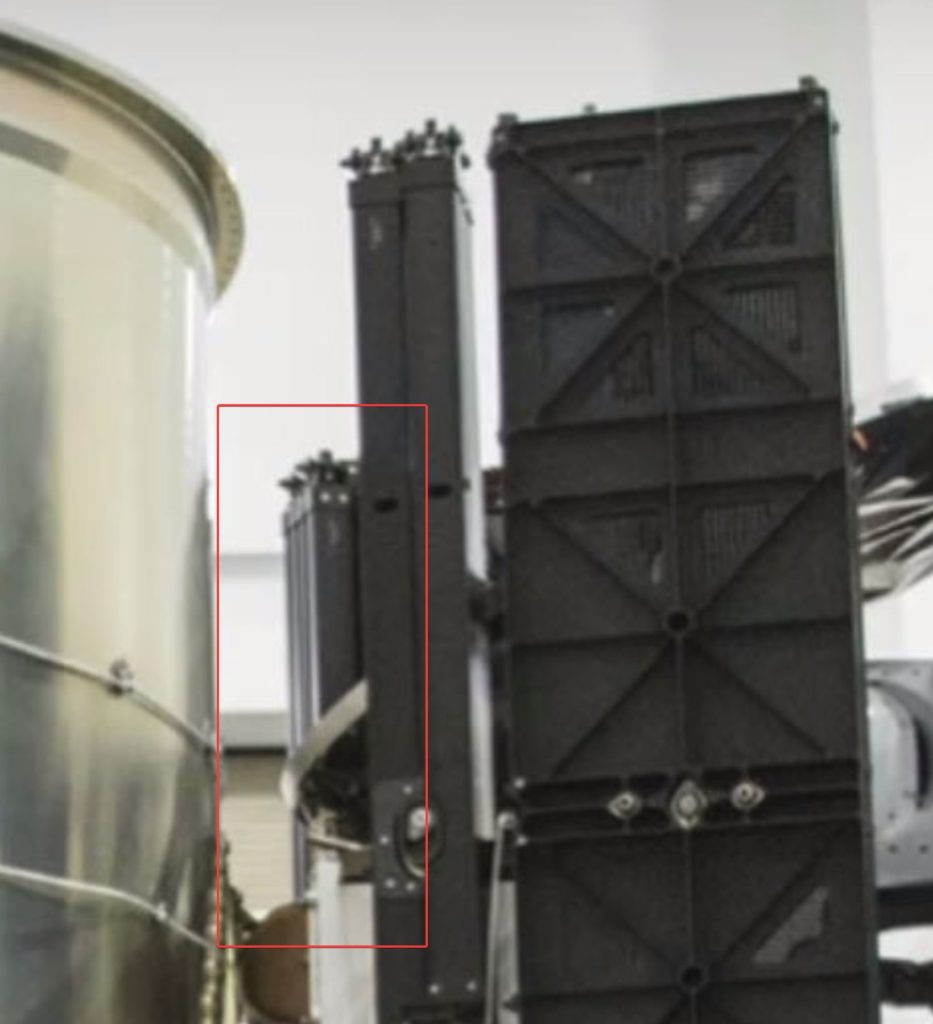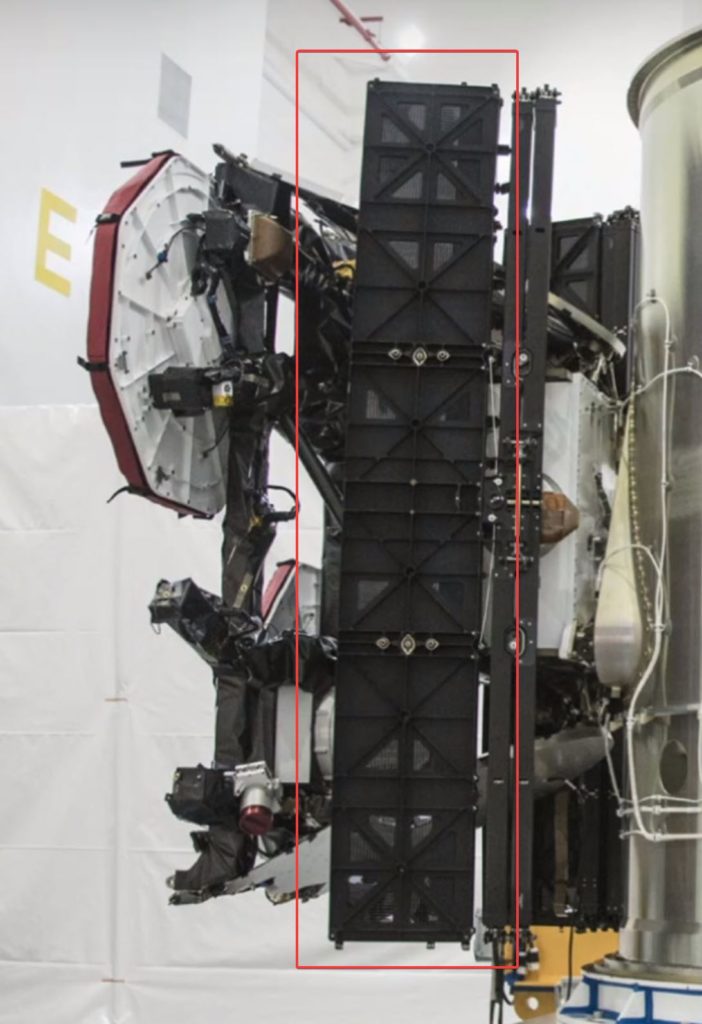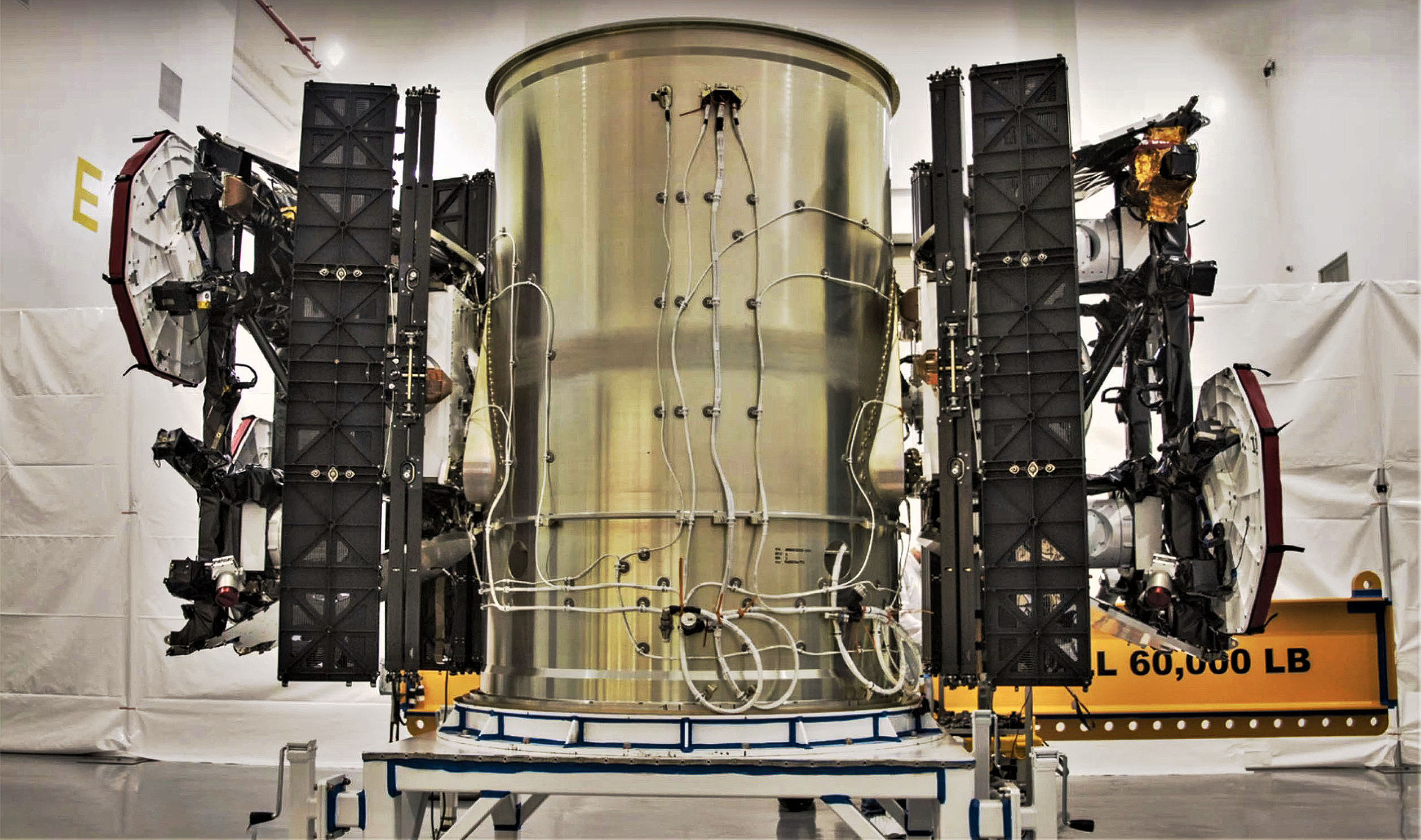
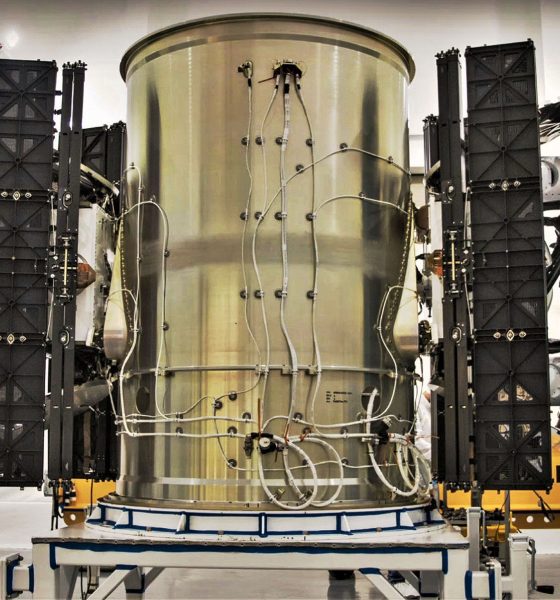
SpaceX
SpaceX’s Starlink satellites may use unique solar array deployment mechanism
Spotted on an official SpaceX T-shirt commemorating Starlink’s first two prototype satellites and corroborated through analysis of limited public photos of the spacecraft, SpaceX appears to be testing a relatively unique style of solar arrays on the first two satellites launched into orbit, known as Tintin A (Alice) and B (Bob).
It’s difficult to judge anything concrete from the nature of what may be immature prototypes, but SpaceX’s decision to take a major step away from its own style of solar expertise – Cargo Dragon’s traditional rigid panel arrays – is almost certainly motivated by a need to push beyond the current state of the art of satellite design and production.
- The axis Tintin solar arrays would deploy along. (SpaceX)
- Just like a scissor mechanism, Tintin’s solar arrays have an extremely thin sandwich of what looks like four interlocking leaves. (SpaceX)
- If the thin structure is a scissor deployment mechanism, the wider black section would be a housing for wiring and the solar array panels, likely thin and flexible rectangles that fold out to reach their full 6m length. (SpaceX)
Unlike any discernible solar panel deployment mechanism with a flight history, SpaceX’s Starlink engineers seem to have taken a style of deployment used successfully on the International Space Station and mixed it with a modern style of solar arrays, relying on several flexible panels that can be efficiently packed together and designed to be extremely lightweight. While a major departure from SpaceX’s successful Cargo Dragon solar arrays, the mechanisms visible on the Tintins seem to have the potential to improve upon the packing efficiency, ease of manufacturing, and number of failure modes present on Dragon’s panels.
In essence, those three motivations are indicative of the challenges SpaceX’s Starlink program must solve in a more general sense. In order to even approach SpaceX’s operational aspirations for Starlink (i.e. high-speed internet delivered from space almost anywhere on Earth), the company will need to find ways to mass-produce hundreds or thousands of high-performance satellites annually at a price-per-unit unprecedented in the history of commercial satellites, all while keeping the weight and volume of each satellite as low as possible (no more than a few hundred kilograms).
To give an idea of where the industry currently stands, satellite internet provider Viasat launched its own Viasat-2 spacecraft in 2017. Weighing in around 6500 kg (14300 lb), the immense satellite cost at least $600 million and offers an instantaneous bandwidth of 300 gigabits per second, impressive but also gobsmackingly expensive at $2 million/Gbps. To ever hope to make Starlink a reality, SpaceX will need to beat that value by at least a factor of 5-10, producing Starlink satellites for no more than $1-3 million apiece ($4.5B-$13.5B alone to manufacture the initial 4,425 satellite constellation) with a bandwidth of 20 Gbps – baselined in official statements.
Compared to the state of the art, a $1 million satellite with optical (laser) interlinks, multiple phased array antennae, electric ion propulsion, two 1-2 kW solar arrays, and bandwidth on the order of 20 Gbps is – to put it nicely – wildly ambitious. Fundamentally, SpaceX will need to revolutionize design and mass-production of all of the above subcomponents, and perhaps the unfamiliar solar arrays present on the Tintin twins are a first step towards tackling at least one of those revolutions-in-waiting.
Will do another rev before final design
— Elon Musk (@elonmusk) May 27, 2018
According to CEO Elon Musk, another set of prototype satellites will likely be launched and tested in orbit before settling on a finalized Starlink design.
For prompt updates, on-the-ground perspectives, and unique glimpses of SpaceX’s rocket recovery fleet check out our brand new LaunchPad and LandingZone newsletters!

Elon Musk
Starlink achieves major milestones in 2025 progress report
Starlink wrapped up 2025 with impressive growth, adding more than 4.6 million new active customers and expanding service to 35 additional countries, territories, and markets.

Starlink wrapped up 2025 with impressive growth, adding more than 4.6 million new active customers and expanding service to 35 additional countries, territories, and markets. The company also completed deployment of its first-generation Direct to Cell constellation, launching over 650 satellites in just 18 months to enable cellular connectivity.
SpaceX highlighted Starlink’s impressive 2025 progress in an extensive report.
Key achievements from Starlink’s 2025 Progress
Starlink connected over 4.6 million new customers with high-speed internet while bringing service to 35 more regions worldwide in 2025. Starlink is now connecting 9.2 million people worldwide. The service achieved this just weeks after hitting its 8 million customer milestone.
Starlink is now available in 155 markets, including areas that are unreachable by traditional ISPs. As per SpaceX, Starlink has also provided over 21 million airline passengers and 20 million cruise passengers with reliable high-speed internet connectivity during their travels.
Starlink Direct to Cell
Starlink’s Direct to Cell constellation, more than 650 satellites strong, has already connected over 12 million people at least once, marking a breakthrough in global mobile coverage.
Starlink Direct to Cell is currently rolled out to 22 countries and 6 continents, with over 6 million monthly customers. Starlink Direct to Cell also has 27 MNO partners to date.
“This year, SpaceX completed deployment of the first generation of the Starlink Direct to Cell constellation, with more than 650 satellites launched to low-Earth orbit in just 18 months. Starlink Direct to Cell has connected more than 12 million people, and counting, at least once, providing life-saving connectivity when people need it most,” SpaceX wrote.
Elon Musk
Starlink passes 9 million active customers just weeks after hitting 8 million
The milestone highlights the accelerating growth of Starlink, which has now been adding over 20,000 new users per day.

SpaceX’s Starlink satellite internet service has continued its rapid global expansion, surpassing 9 million active customers just weeks after crossing the 8 million mark.
The milestone highlights the accelerating growth of Starlink, which has now been adding over 20,000 new users per day.
9 million customers
In a post on X, SpaceX stated that Starlink now serves over 9 million active users across 155 countries, territories, and markets. The company reached 8 million customers in early November, meaning it added roughly 1 million subscribers in under seven weeks, or about 21,275 new users on average per day.
“Starlink is connecting more than 9M active customers with high-speed internet across 155 countries, territories, and many other markets,” Starlink wrote in a post on its official X account. SpaceX President Gwynne Shotwell also celebrated the milestone on X. “A huge thank you to all of our customers and congrats to the Starlink team for such an incredible product,” she wrote.
That growth rate reflects both rising demand for broadband in underserved regions and Starlink’s expanding satellite constellation, which now includes more than 9,000 low-Earth-orbit satellites designed to deliver high-speed, low-latency internet worldwide.
Starlink’s momentum
Starlink’s momentum has been building up. SpaceX reported 4.6 million Starlink customers in December 2024, followed by 7 million by August 2025, and 8 million customers in November. Independent data also suggests Starlink usage is rising sharply, with Cloudflare reporting that global web traffic from Starlink users more than doubled in 2025, as noted in an Insider report.
Starlink’s momentum is increasingly tied to SpaceX’s broader financial outlook. Elon Musk has said the satellite network is “by far” the company’s largest revenue driver, and reports suggest SpaceX may be positioning itself for an initial public offering as soon as next year, with valuations estimated as high as $1.5 trillion. Musk has also suggested in the past that Starlink could have its own IPO in the future.
News
SpaceX shades airline for seeking contract with Amazon’s Starlink rival

SpaceX employees, including its CEO Elon Musk, shaded American Airlines on social media this past weekend due to the company’s reported talks with Amazon’s Starlink rival, Leo.
Starlink has been adopted by several airlines, including United Airlines, Qatar Airways, Hawaiian Airlines, WestJet, Air France, airBaltic, and others. It has gained notoriety as an extremely solid, dependable, and reliable option for airline travel, as traditional options frequently cause users to lose connection to the internet.
Many airlines have made the switch, while others continue to mull the options available to them. American Airlines is one of them.
A report from Bloomberg indicates the airline is thinking of going with a Starlink rival owned by Amazon, called Leo. It was previously referred to as Project Kuiper.
American CEO Robert Isom said (via Bloomberg):
“While there’s Starlink, there are other low-Earth-orbit satellite opportunities that we can look at. We’re making sure that American is going to have what our customers need.”
Isom also said American has been in touch with Amazon about installing Leo on its aircraft, but he would not reveal the status of any discussions with the company.
The report caught the attention of Michael Nicolls, the Vice President of Starlink Engineering at SpaceX, who said:
“Only fly on airlines with good connectivity… and only one source of good connectivity at the moment…”
CEO Elon Musk replied to Nicolls by stating that American Airlines risks losing “a lot of customers if their connectivity solution fails.”
American Airlines will lose a lot of customers if their connectivity solution fails
— Elon Musk (@elonmusk) December 14, 2025
There are over 8,000 Starlink satellites in orbit currently, offering internet coverage in over 150 countries and territories globally. SpaceX expands its array of satellites nearly every week with launches from California and Florida, aiming to offer internet access to everyone across the globe.
Currently, the company is focusing on expanding into new markets, such as Africa and Asia.
